|
80x5 -
240x3 -
240x4 -
320x1 -
320x2 -
320x3 -
640x1 -
640x2
Set display option above.
Click on
images to enlarge. |
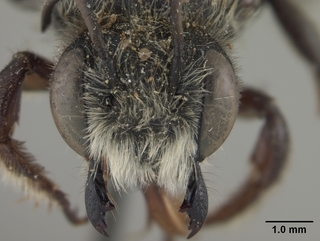
Smithsonian Institution, Entomology Department · 9
Megachile gemula, male, face |
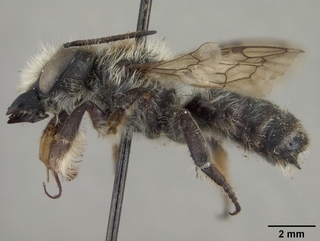
Smithsonian Institution, Entomology Department · 9
Megachile gemula, male, side |
|
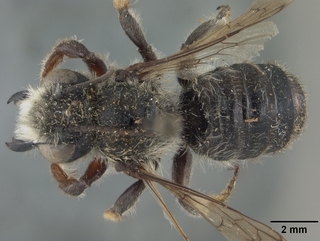
Smithsonian Institution, Entomology Department · 9
Megachile gemula, male, top |
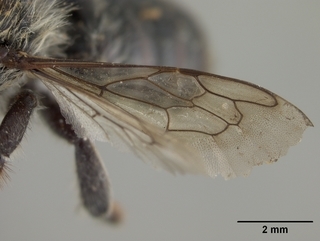
Smithsonian Institution, Entomology Department · 9
Megachile gemula, male, wing |
|
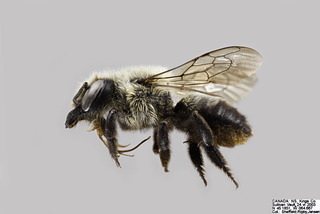
© Copyright Laurence Packer 2014
· 7
Megachile gemula FEM f |
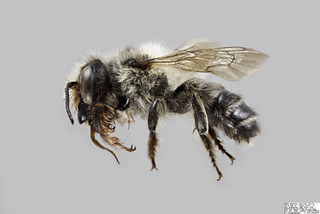
© Copyright Laurence Packer 2014
· 7
Megachile gemula MALE f |
|
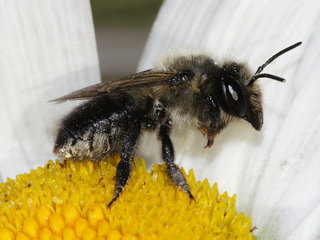
Michael Veit · 6
Megachile gemula, f |
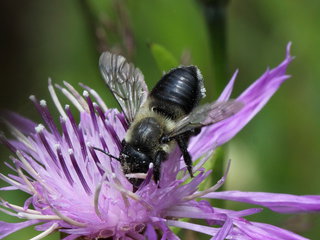
Michael Veit · 6
Megachile gemula, f on Centauria -- |
|
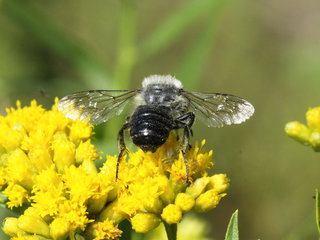
Michael Veit · 6
Megachile gemula, m on Solidago -- |
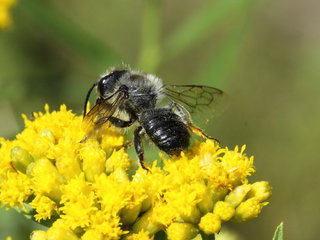
Michael Veit · 6
Megachile gemula, m on Solidago -- |
|
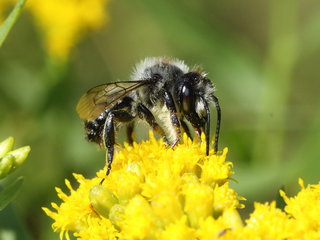
Michael Veit · 6
Megachile gemula, m on Solidago -- |
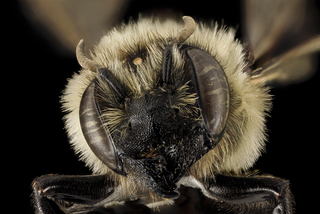
© Copyright source/photographer
· 5
Megachile gemula, F, Face, MD, PG County |
|
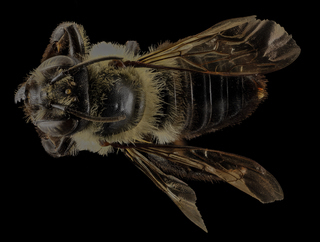
© Copyright source/photographer
· 5
Megachile gemula, F, Back, PG county, MD |
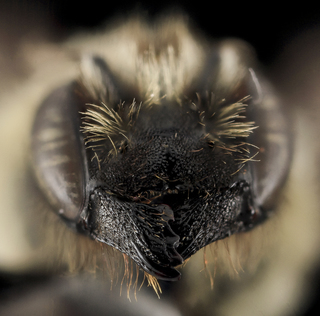
© Copyright source/photographer
· 5
Megachile gemula, F, Face, PG county, MD |
|
Overview | |
Identification Notes: Male has only scattered thin hairs on the tergites with no distinct hair bands like many of the other Megachile. At first glance they will all look light, but upon closer inspection you will see that the T3 - T6 has dark colored hairs at least in the center of the tergites.
Reprinted with permission from: Mitchell, T.B. 1962 Bees of the Eastern United States. North Carolina Agricultural Experiment Station Technical Bulletin No. 152.
FEMALE — Length 12-15 mm.; entirely black, including tegulae and legs, spurs more brownish-testaceous; eyes subparallel; ely- peal margin nearly straight, with a short, median area narrowly shining and impunctate; mandibles 4-dentate, inner tooth very broadly truncate; lateral ocelli subequally distant from eyes and margin of vertex; cheeks slightly broader than eyes; vertex somewhat shining, punctures rather fine, quite close medially, becoming somewhat more widely separated laterally, minute and close on cheeks; face below ocelli with moderately coarse, contiguous punctures, becoming minutely and closely punctate laterally, supraclypeal area somewhat shining and sparsely punctate medially, becoming close
sides, somewhat separated in mid-line of clypeus, becoming quite densely crowded but rather coarse on each side; pubescence of headpale in part but intermixed with fuscous or blackish hairs over lower half of face and on cheeks medially and above, vertex with some very short, dark hairs and long, erect, pale hairs; thorax with rather dense and elongate pale pubescence laterally and posteriorly, scutum and scutellum covered quite densely with rather long, pale yellowish or whitish hairs, with varying amounts of fuscous hairs intermixed over posterior half of scutum; punctures of scutum quite deep and distinct, not very coarse, rather well separated medially but otherwise quite close or densely crowded, those on scutellum somewhat finer, sparse on midline but close laterally, very fine and close on axillae; pleura rather dull, with rather fine and densely crowded punctures; propodeum somewhat smoother but dull, punctures hardly evident; mid and hind basitarsi rather broad but distinctly shorter than tibiae, front tarsi rather short and slender; legs in large part short black pubescent, outer face of mid basitarsi with more brownish pubescence; tegulae somewhat shining, very minutely and closely punctate; wings sub-hyaline, becoming faintly infuscated apically, veins brownishtestaceous; abdominal ‘terga 2-4 shallowly grooved across base, basal margins of the grooves quite distinct but hardly carinate, 4
with a basal impression but not a definite groove; apical margins shallowly depressed, but completely lacking fasciae; discal pubescence of terga 1 and 2 and base of 3 erect, entirely pale, but rather thin, that on 4-6 and apex of 3 erect, rather dense but short, entirely black; surface of terga shining, punctures minute, slightly separated in large part, becoming close toward extreme sides; tergum 6 about straight, with abundant, erect, blackish hairs evident in profile; sternum 6 rather well covered with dark scopal hairs, bare in part toward tip, with a dense fringe of short, fuscous hairs; scopa otherwise entirely black, basal sterna very closely and finely punctate, but punctures somewhat more widely separated on the more apical sterna, apical margins very narrowly yellowish-hyaline, sternal fasciae not evident.
MALE — Length 8-11 mm.; black, including tegulae and legs in large part; eyes very slightly convergent below; clypeal margin nearly straight, with a very small, median emargination; mandibles distinctly 4-dentate (fig. 43), with an acute, basal inferior process, which is very broadly triangular, with a broad base; apical segment of flagellum very slightly dilated; lateral ocelli very slightly nearer margin of vertex than to eyes; cheeks somewhat broader than eyes, somewhat excavated below lower end of eye, lower margin of this produced as a prominant, carinate tubercle; punctures of vertex quite deep and distinct, rather coarse, slightly but not widely separated, becoming closer on cheeks above, but more densely, irregularly rugose below, face below ocelli with relatively coarse, close punctures, these nearly contiguous, lateral areas of face and supraclypeal area becoming densely and very finely rugose, punctures of clypeus beneath pubescence rather coarse and quite close above, becoming very fine and densely crowded below; pubescence copious, elongate and yellowish-white on face and clypeus, somewhat more white and quite copious on cheeks below, thin above, and whitish on thorax laterally and posteriorly, vertex and dorsum of thorax with elongate, erect but somewhat thinner pubescence, with a few dark hairs interspersed and a considerable amount of shorter, blackish pubesence on vertex laterally and on upper part of cheeks; scutum quite closely, deeply and distinctly punctate throughout, punctures of scutellum slightly finer but very close, and axillae with very fine, densely crowded punctures; pleura rather dull, punctures very close, rather coarse below, becoming fine above; propodeum somewhat smoother but dull, with only exceedingly minute and vague punctures evident; front coxal spines rather short but erect and rather slender, subacute, surface of coxa with a small patch of short, fuscous setaejust anterior to the spine; mid tibial spurs rather short but distinct; front basitarsi somewhat dilated and quite deeply excavated, although largely black, becoming somewhat yellowish along posterior margin, following segments also yellow along posterior margin, segments 1-3 with a prominant posterior fringe of elongate, white hairs; tegulae somewhat shining, very minutely and closely punctate; wings subhyaline, veins brownish-testaceous; terga 2-4 shallowly depressed at base, but hardly grooved, basal margin abrupt but not can- nate, apical margins of terga rather broadly depressed, more so laterally, these with thin and obscure, whitish, apical fasciae at extreme sides of 2 and 3, a more complete one on 4; terga 1 and 2 with rather elongate but thin, erect, pale pubescence, discal pubescence on 3 and 4 rather elongate, pale basally, becoming blackish apically and largely black on 5; punctures of all terga very fine, well separated or sparse medially, becoming somewhat closer at extreme sides; tergum 5 not fasciate, punctures minute and well separated throughout, 6 closely and minutely punctate above, carina consisting of a pair of triangular, sublateral, carina-like lobes which form a rounded, median, emarginate area, median teeth of apical margin subacute, quite distinct but carinate, much more widely separated from each other than to the obscure, lateral angles which are hardly produced as definite teeth; tergum
short, but rather broad and transverse, not at all angulate medially, but bearing an apical tuft of elongate pubescence; sterna 1-4 largely exposed, shining, very minutely and quite sparsely punctate in general, apical margins depressed, more or less yellowish-hyaline, but not at all fasciate, the plates largely bare; setose area of sternum 5 very short, transverse, with short, scale-like setae (fig. 44) ; sternum 6 with a transverse, linear patch of long, flexed setae on each side, apical lobe broad and very short, angulate at each side; gonocoxites constricted near base, flattened and dilated apically, flexed ventrally, apex narrowly produced (fig. 45).
DISTRIBUTION—Mackenzie to Nova Scotia, south to California and Georgia, April to August.
FLOWER RECORDS—A pocynum, Asclepias, Baptisia, Campanula, Chrysanthemum, Clematis, Coreopsis, Geranium, Gerardia, Hydrangea, Philadeiphus, Pycnanthemum, Rhododendron, Rubus, Rudbeckia, Solidago, Trifolium, Vaccinium and Vicia.
|
|
|
Identification | |
Extracted from: Sheffield C. S., et al (2011). Leaf cutter and Mason Bees of the Genus Megachile Latreille (Hymenoptera; Megachilidae) in Canada and Alaska. Canadian Journal of Arthropod Identification No. 18
Megachile (Xanthosarus) gemula Cresson, 1878
Megachile gemula Cresson, 1878. Trans. Amer. Entomol. Soc. 7: 118 (♂ only).
Megachile avara Cresson, 1878. Trans. Amer. Entomol. Soc. 7: 123 (♂).
Megachile carbonaria Cresson, 1879. Trans. Amer. Entomol. Soc. 7: 208 (♀) (preoccupied).
Megachile vancouveriensis Provancher, 1888. Addit. Corr. Faune Entomol. Canad. Hym. p 424 (♂).
Megachile cressonii Dalla Torre, 1896. Cat. Hym. 10: 427 (replacement name for M. carbonaria Cresson, 1879, not Smith, 1853).
Megachile albula Lovell and Cockerell, 1907. Psyche 14: 18 (♂).
Megachile vandykei Cockerell, 1925. Proc. Calif. Acad. Sci. (4) 14: 205 (♀).
Megachile (Delomegachile) gemula var. fulvogemula Mitchell, 1935. Trans. Amer. Entomol. Soc. 56: 185 (♀).
Diagnosis. The female of M. gemula can be recognized by the combination of the metasoma, which lacks pale apical fasciae on the terga, giving a distinctive pattern of all pale hairs (T1 and T2) and black hairs (T3-T6) in dorsal view, the upper and lower margins of the mandible parallel in lateral view from the base to a length subequal to width prior to tapering, and the broadly truncate inner mandibular tooth. They are most similar to M. circumcincta and M. melanophaea, both which have the mandible tapering gradually but continuously from base to apex in lateral view, and the inner mandibular tooth rounded and narrower and/or with a small excision at its apex. The male of M. gemula is distinct, being the only species in Canada with the front basitarsus dilated and excavated along the anterior margin, but with the colour mostly black (i.e., not conspicuously pale coloured). It is further distinguished by lacking apical fascia on T5.
FEMALE: Length 12-15 mm.
Head. 1) compound eyes subparallel; lateral ocelli subequally distant from eyes and margin of vertex, 2) clypeal margin nearly straight to slightly emarginate medially, with a short, median area that is narrowly shining and impunctate, 3) mandibles 4-dentate, with an incomplete cutting edge between the 2nd and 3rd teeth, complete between 3rd and 4th teeth, inner tooth broadly truncate, mandible with upper and lower margins parallel in lateral view from base to a length subequal to width prior to tapering (Plate 1, Figure M35), 4) gena slightly broader than compound eye (5:4.5), 5) vertex somewhat shining, punctures rather fine, quite close medially, becoming somewhat more widely separated laterally (≤ 1 pd), minute and close on gena; frons with moderately coarse, contiguous punctures, becoming minutely and closely punctate laterally, supraclypeal area somewhat shining and sparsely punctate medially, becoming close laterally, somewhat separated medially on clypeus, approaching an obscure to distinct impunctate band in some specimens, becoming quite densely crowded but rather coarse on each side, 6) pubescence of head above pale in part, brown or blackish hairs over lower half of face, intermixed on supraclypeal area, and along inner margin of compound eyes, on gena medially and above, vertex with some very short, dark hairs and long, erect, pale hairs, 7) F1 longer than broad (3:2) and longer than pedicel and slightly longer that F2, which is quadrate, remaining flagellomeres longer than broad (4:3), apical flagellomere elongate, almost twice as long as broad.
Mesosoma. 1) pubescence pale, rather dense and elongate laterally and posteriorly, becoming brown ventrally, mesoscutum and scutellum covered quite densely with rather long, pale yellowish or whitish hairs, with varying amounts of brownish hairs intermixed over posterior half of mesoscutum; front femur with long pale hair on outer surface, legs otherwise with short black pubescent, outer face of mid basitarsus with more brownish pubescence, 2) punctures of mesoscutum and scutellum quite deep and distinct, not very coarse, rather well separated medially but otherwise quite close or densely crowded, very fine and close on axilla; pleura rather dull, with rather fine and densely crowded punctures; propodeum somewhat smoother but dull, punctures hardly evident, triangle dull and impunctate, 3) mid and hind basitarsi rather broad but distinctly shorter than their tibiae, front tarsi rather short and slender, spurs more yellowish-brown, 4) tegula somewhat shining, very minutely and closely punctate throughout, 5) wings sub-hyaline, becoming faintly infuscated apically, veins brownish.
Metasoma. 1) T2-T4 shallowly grooved across base, basal margins of the grooves quite distinct but not carinate, T4 with a basal impression but not a definite groove; apical margins shallowly depressed; all terga lacking fasciae; discal pubescence of T1 and T2 erect, entirely pale, but rather sparse, that on T4-T6 and apex of T3 erect, rather dense but short, entirely black; surface of terga shining, punctures minute, slightly separated in large part, becoming close toward sides; T6 straight in profile, with abundant, erect, blackish hairs, 2) S6 rather well covered with dark scopal hairs, bare in part toward tip, with a dense fringe of short, brownish hairs; scopa otherwise entirely black, basal sterna very closely and finely punctate, but punctures somewhat more widely separated on the more apical sterna, apical margins very narrowly yellowish-hyaline.
MALE: Length 8-11 mm.
Head. 1) compound eyes slightly convergent below; lateral ocelli subequally distant from eyes and margin of vertex, 2) clypeal margin nearly straight, with a very small, median emargination between two tubercles, 3) mandibles distinctly 4-dentate, lower process acute, very broadly triangular with a broad base, basal in position, 4) gena subequal to compound eye in width, somewhat excavated below lower end of eye, lower margin of this produced as a prominent, carinate tubercle, 5) punctures of vertex quite deep and distinct, rather coarse, slightly separated laterally, becoming closer on gena above, but more densely and irregularly rugose below, frons with relatively coarse, close, nearly contiguous punctures, paraocular and supraclypeal areas becoming densely and very finely rugose, punctures of clypeus beneath pubescence rather coarse and quite close above, becoming very fine and densely crowded below, 6) pubescence copious, elongate and yellowish-white on face and clypeus, somewhat more white and quite copious on gena below, vertex with long erect but somewhat sparser, mostly black pubescence that extends on vertex laterally and on upper part of gena, becoming shorter but extending 2/3 down inner margin of compound eye, 7) F1 about as long as broad, subequal in length to pedicel, shorter than F2 which is slightly longer than broad (2.5:2), remaining flagellomeres longer than broad (3:2), apical flagellomere very slightly dilated.
Mesosoma. 1) pubescence whitish laterally and posteriorly, dorsal surface with elongate, erect but somewhat sparser pubescence, with a few dark hairs intermixed, 2) mesoscutum quite closely, deeply and distinctly punctate throughout, punctures of scutellum slightly finer but very close, and axilla with very fine, densely crowded punctures; pleura rather dull, punctures very close, rather coarse below, becoming fine above; propodeum somewhat smoother but dull, with only exceedingly minute and vague punctures evident, triangle dull and impunctate, 3) front coxal spine rather short but erect and rather slender, subacute, surface of coxa with a small patch of short, reddish setae just anterior to the spine; front basitarsus somewhat dilated and quite deeply excavated, largely black, becoming somewhat yellowish along posterior margin, following tarsomeres yellow along posterior margin, tarsomeres 1-3 with a prominent posterior fringe of elongate, white hairs, mid tibial spurs rather short but distinct, mid and hind basitarsi much narrower and shorter than their tibiae, 4) tegula somewhat shining, very minutely and closely punctate, 5) wings subhyaline, veins brownish.
Metasoma. 1) T2-T4 shallowly depressed at base, but hardly grooved, basal margin abrupt but not carinate, apical margins of terga rather broadly depressed, more so laterally, T2 and T3 with obscure, whitish, apical fasciae at sides, a more complete one on T4; T1 and T2 with rather elongate but sparse, erect, pale pubescence, discal pubescence on T3 and T4 rather elongate, pale basally, becoming blackish apically and largely black on T5, pubescence of T6 sparse, long, and largely pale; punctures of all terga very fine, well separated or sparse medially, becoming somewhat closer at extreme sides; T5 not fasciate, punctures minute and well separated throughout, T6 closely and minutely punctate above, carina consisting of a pair of triangular, sublateral, carina-like lobes that form a rounded, median, emarginate area, median teeth of apical margin subacute, quite distinct but carinate, much more widely separated from each other than to the obscure, lateral angles, which are scarcely produced as definite teeth; T7 short, but rather broad and transverse, not at all angulate medially, but with an apical tuft of elongate pubescence, 2) S1-S4 exposed, shining, very minutely and generally quite sparsely punctate, apical margins depressed, more or less yellowish-hyaline, but not at all fasciate, the sterna largely bare.
Genitalia. Plate 2, Figure G35.
Discussion. Megachile gemula is a common ground-nesting species. Further work may suggest that the colour variants M. gemula cressonii and M. gemula fulvogemula are additional distinct western species (the range of the latter extending into southern BC); females of these forms show consistent colour differences, though males are difficult to distinguish from the nominal form. Almost 2% divergence in CO1 separates individuals of M. gemula from these forms, which show little difference from each other.
|
|
|
Names | |
|
|
| Supported by | |
Updated: 2024-04-26 22:34:19 gmt
|